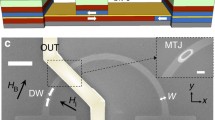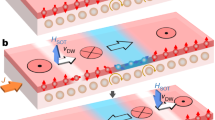Abstract
One of the key challenges for future electronic memory and logic devices is finding viable ways of moving from today’s two-dimensional structures, which hold data in an x–y mesh of cells, to three-dimensional structures in which data are stored in an x–y–z lattice of cells. This could allow a many-fold increase in performance. A suggested solution is the shift register1,2—a digital building block that passes data from cell to cell along a chain. In conventional digital microelectronics, two-dimensional shift registers are routinely constructed from a number of connected transistors. However, for three-dimensional devices the added process complexity and space needed for such transistors would largely cancel out the benefits of moving into the third dimension. ‘Physical’ shift registers, in which an intrinsic physical phenomenon is used to move data near-atomic distances, without requiring conventional transistors, are therefore much preferred. Here we demonstrate a way of implementing a spintronic unidirectional vertical shift register between perpendicularly magnetized ferromagnets of subnanometre thickness, similar to the layers used in non-volatile magnetic random-access memory3. By carefully controlling the thickness of each magnetic layer and the exchange coupling between the layers, we form a ratchet that allows information in the form of a sharp magnetic kink soliton to be unidirectionally pumped (or ‘shifted’) from one magnetic layer to another. This simple and efficient shift-register concept suggests a route to the creation of three-dimensional microchips for memory and logic applications.



Similar content being viewed by others
References
Parkin, S. S. P., Hayashi, M. & Thomas, L. Magnetic domain-wall racetrack memory. Science 320, 190–194 (2008)
Allwood, D. A. et al. Magnetic domain-wall logic. Science 309, 1688–1692 (2005)
Kawahara, T., Ito, K., Takemura, R. & Ohno, H. Spin-transfer torque RAM technology: review and prospect. Microelectron. Reliab. 52, 613–627 (2012)
Hellwig, O., Berger, A., Kortright, J. B. & Fullerton, E. E. Domain structure and magnetization reversal of antiferromagnetically coupled perpendicular films. J. Magn. Magn. Mater. 319, 13–55 (2007)
Wang, R. W., Mills, D. L., Fullerton, E. E., Mattson, J. E. & Bader, S. D. Surface spin-flop transition in Fe/Cr(211) superlattices — experiment and theory. Phys. Rev. Lett. 72, 920–923 (1994)
Mühlbauer, S. et al. Skyrmion lattice in a chiral magnet. Science 323, 915–919 (2009)
Seki, S., Yu, X. Z., Ishiwata, S. & Tokura, Y. Observation of skyrmions in a multiferroic material. Science 336, 198–201 (2012)
Baryakhtar, V. G., Chetkin, M. V., Ivanov, B. A. & Gadetskii, S. N. Dynamics of Topological Magnetic Solitons: Experiments and Theory (Springer, 1994)
Lavrijsen, R. et al. Tuning the interlayer exchange coupling between single perpendicularly magnetized CoFeB layers. Appl. Phys. Lett. 100, 052411 (2012)
Kronmller, H., Parkin, S., eds. Handbook of Magnetism and Advanced Magnetic Materials Vols 1–5 (Wiley, 2007)
Lavrijsen, R. et al. Reduced domain wall pinning in ultrathin Pt/Co100−xBx/Pt with perpendicular magnetic anisotropy. Appl. Phys. Lett. 96, 022501 (2010)
Lemerle, S. et al. Domain wall creep in an Ising ultrathin magnetic film. Phys. Rev. Lett. 80, 849–852 (1998)
Bruno, P. et al. Hysteresis properties of ultrathin ferromagnetic films. J. Appl. Phys. 68, 5759–5766 (1990)
Sbiaa, R., Meng, H. & Piramanayagam, S. N. Materials with perpendicular magnetic anisotropy for magnetic random access memory. Phys. Status Solidi RRL 5, 413–419 (2011)
Gajek, M. et al. Spin torque switching of 20nm magnetic tunnel junctions with perpendicular anisotropy. Appl. Phys. Lett. 100, 132408 (2012)
Langholz, G., Kandel, A. & Mott, J. L. Foundations of Digital Logic Design (World Scientific, 1998)
Thomson, T., Hu, G. & Terris, B. D. Intrinsic distribution of magnetic anisotropy in thin films probed by patterned nanostructures. Phys. Rev. Lett. 96, 257204 (2006)
Baltz, V. et al. Multilevel magnetic nanodot arrays with out of plane anisotropy: the role of intra-dot magnetostatic coupling. Eur. Phys. J. Appl. Phys. 39, 33–38 (2007)
Baltz, V. et al. Balancing interlayer dipolar interactions in multilevel patterned media with out-of-plane magnetic anisotropy. Appl. Phys. Lett. 94, 052503 (2009)
Tudosa, I., Katine, J. A., Mangin, S. & Fullerton, E. E. Perpendicular spin-torque switching with a synthetic antiferromagnetic reference layer. Appl. Phys. Lett. 96, 212504 (2010)
Acknowledgements
R.L. was supported by the Netherlands Organization for Scientific Research and Marie Curie Cofund Action (NWO-Rubicon 680-50-1024). A.F.-P. was supported by a Marie Curie IEF within the Seventh European Community Framework Programme No. 251698; 3DMAG-NANOW. We acknowledge research funding from the European Community under the Seventh Framework Programme Contract No. 247368: 3SPIN.
Author information
Authors and Affiliations
Contributions
R.L. and R.P.C. planned the experiment; R.L. fabricated the samples; R.L. and J.-H.L. performed the experiments; D.C.M.C.P. performed the dipole field calculations; R.L. analysed the data and wrote the manuscript. All authors discussed the results and contributed to the scientific interpretation as well as to the writing of the manuscript.
Corresponding author
Ethics declarations
Competing interests
R.P.C. and D.C.M.C.P. declare a financial interest: patents related to this research have been filed by the University of Cambridge. The University’s policy is to share financial rewards from the exploitation of patents with the inventors. The remaining authors declare no competing financial interests.
Supplementary information
Supplementary Information
This file contains Supplementary Text and Data, Supplementary Figures 1-6 and additional references. (PDF 1300 kb)
Rights and permissions
About this article
Cite this article
Lavrijsen, R., Lee, JH., Fernández-Pacheco, A. et al. Magnetic ratchet for three-dimensional spintronic memory and logic. Nature 493, 647–650 (2013). https://doi.org/10.1038/nature11733
Received:
Accepted:
Published:
Issue Date:
DOI: https://doi.org/10.1038/nature11733
- Springer Nature Limited
This article is cited by
-
Influence of ferromagnetic interlayer exchange coupling on current-induced magnetization switching and Dzyaloshinskii–Moriya interaction in Co/Pt/Co multilayer system
Scientific Reports (2024)
-
Three-dimensional skyrmionic cocoons in magnetic multilayers
Nature Communications (2022)
-
Electronic materials with nanoscale curved geometries
Nature Electronics (2022)
-
Information storage in permalloy modulated magnetic nanowires
Scientific Reports (2021)
-
Skyrmion ratchet propagation: utilizing the skyrmion Hall effect in AC racetrack storage devices
Scientific Reports (2021)





